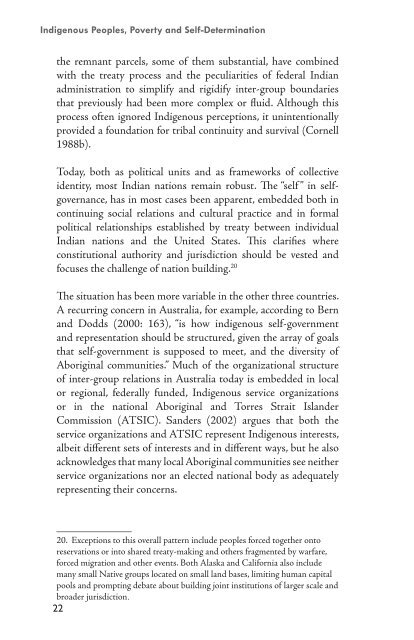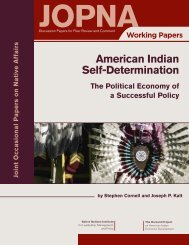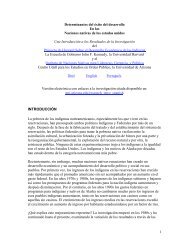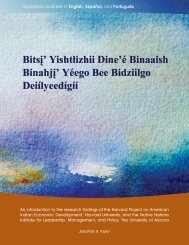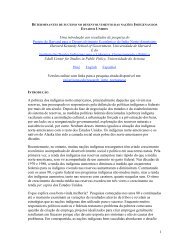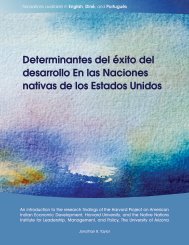Indigenous Peoples, Poverty, and Self-Determination in Australia ...
Indigenous Peoples, Poverty, and Self-Determination in Australia ...
Indigenous Peoples, Poverty, and Self-Determination in Australia ...
You also want an ePaper? Increase the reach of your titles
YUMPU automatically turns print PDFs into web optimized ePapers that Google loves.
<strong>Indigenous</strong> <strong>Peoples</strong>, <strong>Poverty</strong> <strong>and</strong> <strong>Self</strong>-<strong>Determ<strong>in</strong>ation</strong>the remnant parcels, some of them substantial, have comb<strong>in</strong>edwith the treaty process <strong>and</strong> the peculiarities of federal Indianadm<strong>in</strong>istration to simplify <strong>and</strong> rigidify <strong>in</strong>ter-group boundariesthat previously had been more complex or fluid. Although thisprocess often ignored <strong>Indigenous</strong> perceptions, it un<strong>in</strong>tentionallyprovided a foundation for tribal cont<strong>in</strong>uity <strong>and</strong> survival (Cornell1988b).Today, both as political units <strong>and</strong> as frameworks of collectiveidentity, most Indian nations rema<strong>in</strong> robust. The “self ” <strong>in</strong> selfgovernance,has <strong>in</strong> most cases been apparent, embedded both <strong>in</strong>cont<strong>in</strong>u<strong>in</strong>g social relations <strong>and</strong> cultural practice <strong>and</strong> <strong>in</strong> formalpolitical relationships established by treaty between <strong>in</strong>dividualIndian nations <strong>and</strong> the United States. This clarifies whereconstitutional authority <strong>and</strong> jurisdiction should be vested <strong>and</strong>focuses the challenge of nation build<strong>in</strong>g. 20The situation has been more variable <strong>in</strong> the other three countries.A recurr<strong>in</strong>g concern <strong>in</strong> <strong>Australia</strong>, for example, accord<strong>in</strong>g to Bern<strong>and</strong> Dodds (2000: 163), “is how <strong>in</strong>digenous self-government<strong>and</strong> representation should be structured, given the array of goalsthat self-government is supposed to meet, <strong>and</strong> the diversity ofAborig<strong>in</strong>al communities.” Much of the organizational structureof <strong>in</strong>ter-group relations <strong>in</strong> <strong>Australia</strong> today is embedded <strong>in</strong> localor regional, federally funded, <strong>Indigenous</strong> service organizationsor <strong>in</strong> the national Aborig<strong>in</strong>al <strong>and</strong> Torres Strait Isl<strong>and</strong>erCommission (ATSIC). S<strong>and</strong>ers (2002) argues that both theservice organizations <strong>and</strong> ATSIC represent <strong>Indigenous</strong> <strong>in</strong>terests,albeit different sets of <strong>in</strong>terests <strong>and</strong> <strong>in</strong> different ways, but he alsoacknowledges that many local Aborig<strong>in</strong>al communities see neitherservice organizations nor an elected national body as adequatelyrepresent<strong>in</strong>g their concerns.20. Exceptions to this overall pattern <strong>in</strong>clude peoples forced together ontoreservations or <strong>in</strong>to shared treaty-mak<strong>in</strong>g <strong>and</strong> others fragmented by warfare,forced migration <strong>and</strong> other events. Both Alaska <strong>and</strong> California also <strong>in</strong>cludemany small Native groups located on small l<strong>and</strong> bases, limit<strong>in</strong>g human capitalpools <strong>and</strong> prompt<strong>in</strong>g debate about build<strong>in</strong>g jo<strong>in</strong>t <strong>in</strong>stitutions of larger scale <strong>and</strong>broader jurisdiction.22


